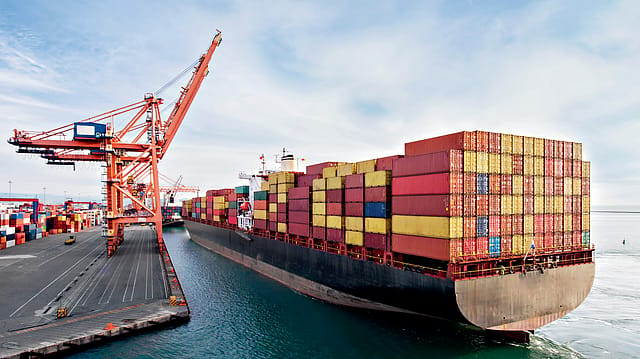Exports dip 6.6% to $33 bn in Jan; trade deficit at $17.7 bn
ADVERTISEMENT

The country's exports declined 6.58% to $32.91 billion in January 2023 against $35.23 billion during the corresponding period last year, the data released by the commerce ministry shows. Imports, on the other hand, dipped 3.63% to $50.66 billion in January 2023, down from 52.57 billion in the year-ago period. With this, the country's trade deficit in January stood at $17.75 billion.
India's exports had declined by 5.2% YoY to $61.82 billion in December 2022 against $65.25 billion in the year-ago period. The imports in the month declined 1.9% YoY to $73.80 billion against $75.27 billion in December 2021.
India's trade deficit had ballooned to $83.5 billion in the financial year 2021-22, a manifold rise from the Covid-hit year of 2020-21 when the trade deficit stood at $13.2 billion. A year before that, the country's trade deficit was at $76.4 billion.
The Netherlands had emerged as India's third-largest export destination after the U.S. and the U.A.E. during the April-December period of FY2022-23, primarily due to the increase in shipments of petroleum products, electronic items, chemicals and aluminium goods.
December 2025
The annual Fortune 500 India list, the definitive compendium of corporate performance, is out. This year, the cumulative revenue of the Fortune 500 India companies has breached $2 trillion for the first time. Plus, find out which are the Best B-schools in India.
India’s overall exports (merchandise and services combined) in April-December 2022 exhibited a positive growth of 16.11% over the same period last year (April-December 2021). In value terms, India’s overall exports were at $568.57 billion and imports were at $686.70 billion.
The trade deficit for the first three-quarters of FY23, however, touched a historic high of 6% of the GDP (deficit of $118 billion or Rs 9.4 lakh crore @Rs80 in the GDP of Rs 157.6 lakh crore). For the full fiscal of FY23, the trade deficit is likely to reach far higher – putting tremendous pressure on forex reserves.
According to the government data, India’s overall export (merchandise plus services) exports increased from $489.7 billion in 2021-22 (April-December) to $576.1 billion in 2022-23 (April-December), a 17.64% growth. The Centre says to address the trade deficit, it has extended the Foreign Trade Policy up to March 31, 2023. The government has also extended the Interest Equalisation Scheme on pre and post-shipment rupee export credit till March 31, 2024.
Also, to discourage unnecessary imports from some of the countries with which India shares its borders, the Centre says it has taken measures such as enhancing domestic capacity, incentivising domestic manufacturing through Production Linked Incentive (PLI) schemes, phased manufacturing plans, timely use of trade remedy options, adoption of mandatory technical standards, enforcement of FTA Rules of Origin (RoO) and development of import monitoring system.
With China, which is one of the biggest exporters in the world, India's trade deficit was $73.31 billion in 2021-22. The trade deficit during the period April-November 2022 stood at $58 billion. India's exports to China were steady during 2020-21 and 2021-22 at $21.19 billion and $21.26 billion, respectively. From April-December 2022, India’s export to China was at $11.01 billion. The Centre says the decrease in exports to China is attributed to a slowdown in the Chinese economy, which led to a slowing in demand for goods.
